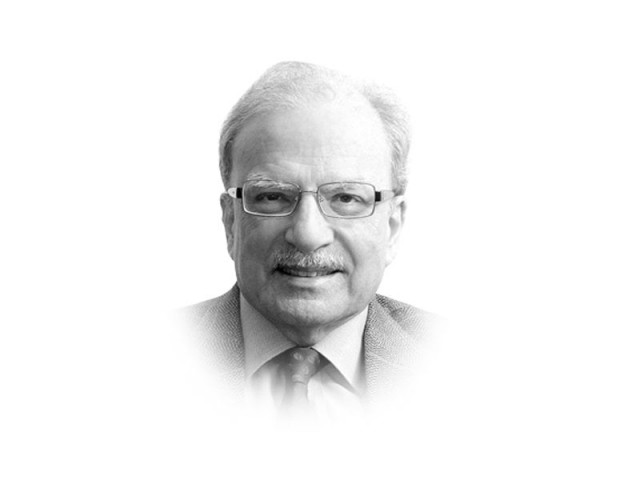Rearming of the world with lethal weaponry
Military commanders believe treaty with Russia restricts US from building new weapons

The writer is a former caretaker finance minister and served as vice-president of the World Bank
He was also persuaded that the previous administrations — not just the one headed by president Obama — had bound his country in international treaties that were preventing it from using its very large industrial base and technological superiority with which it could build weapons no other country could match.
He was interested in making greater investment in developing nuclear weapons and the means for delivering them. But international obligations served as a constraint in moving in that direction.
The movement for controlling the development of nuclear weapons began in 1945 with Canada and Britain taking the lead. In June 1946, Bernard Baruch, a representative of President Harry S Truman, proposed what came to be known as the Baruch Plan before the Atomic Energy Commission.
The plan suggested an international system of controls on the production and use of nuclear energy. The Baruch plan served as the basis for the United States nuclear policy into the 1970s but was rejected by the Soviet Union. The Moscow leadership believed that it was a conspiracy to have the United States preserve its monopoly over the use of nuclear power.
The opposition from the Soviet Union did not prevent international action. Up to the signing of the Partial Test Ban Treaty (PTBP) on August 5, 1963, as many as 499 nuclear tests were conducted.
Between 1945 and 1963, the United States carried out 215 atmospheric tests, the Soviet Union 219, Britain 21 and France three. Underground tests were begun by the US in 1957 with the Soviet Union following.
Opposition had built up to the tests because of heavy nuclear fallout. Because of suspicions on both sides, the more ambitious Comprehensive Test Ban Treaty (CTBT) was proposed but could not win favour; instead most members of the United Nations agreed to the PTBP which was concluded on July 23, 1963.
India, Israel and Pakistan refused to sign both versions of the treaty: the partial ban as well as the comprehensive ban. All three are now nuclear powers.
With the testing of nuclear weapons having been brought under partial control, the United States and the Soviet Union turned their attention to managing delivery systems, in particular missiles. The two countries agreed to the Intermediate-Range Nuclear Forces (INF) agreement. It was signed by presidents Ronald Regan and Mikhail S Gorbachev in 1987.
The treaty’s origins lay in deployment by the Soviet Union in 1977 of a mobile missile called SS-20 that was developed to target European cities. The missiles had three nuclear warheads, each of which could be targeted at a different city.
The Soviets were working on developing missiles that had even longer ranges and this bothered the administration in Washington. The INF was followed by the much larger New Start agreement signed by presidents Barack Obama and Vladimir Putin. It was aimed at reducing the number of missiles possessed by the two countries.
The treaty brought American and Russian nuclear weapons to record low levels of 1,550 deployed intercontinental ballistic missiles when it went into full effect in 2018.
The INF was confined to the United States and Russia but there was an expectation that it would be extended to other nations. That did not happen.
China currently relies on intermediate-range missiles for 95 per cent of its ground-based fleet, and India, Pakistan and North Korea are among the 10 states with similar fast-growing missile arsenals. Washington had two options: to include all the nations that had armed themselves with these weapons in the missile treaty or focus on China as the country’s principal threat.
It chose the second option. Senior military commanders, retired and serving, whose advice Trump values a great deal, believe that the treaty with Russia restricts the United States from investing in and building a new class of conventional and nuclear weapons to counter China’s growing influence in the Pacific. The Chinese arsenal had several hundred missiles with ranges that would violate the INF had the country been a member of the agreement.
Somewhat unexpectedly, the United States delivered an ultimatum to Russia in early December 2018 saying that it was moving towards abandoning the 1987 landmark treaty.
The INF banned all land-based missiles of ranges of 310 to 3,420 miles. The Trump administration said that Russia had 60 days to comply with the INF treaty. It claimed that Moscow was violating the agreement and was covering up testing of missiles that ignored the range limits of the treaty.
A number of former diplomats with experience of working with the Soviet Union on arms control were displeased with the action taken by the Trump administration.
For instance, George P Shultz who had served the Reagan administration as secretary of state and was involved in the negotiations that resulted in the signing of the INF, was troubled by the action taken by Trump. “Now is not the time to build a larger arsenal of nuclear weapons,” he said. “Now is the time to rid the world of this threat. Leaving the treaty would be a step backward. We should fix it, not kill it.”
What is the significance of these developments for Pakistan, a declared nuclear state with a growing arsenal that also includes missiles? India, a long-time rival state, has the same capability. New Delhi has two options.
The first would be to come to an agreement that would limit the size of the arsenals in ways that would be verifiable. The other is to persist with the arms race. It is unlikely that India would accept the first option. It is deeply concerned with China’s growing military strength.
Also, there are many in Pakistan who believe that nuclear and missiles have served to deter India from moving against Pakistan. In the last couple of decades there were times when it seemed that India was poised to attack its neighbour but was prevented from taking that action by Pakistan’s nuclear deterrence.
Published in The Express Tribune, February 11th, 2019.
Like Opinion & Editorial on Facebook, follow @ETOpEd on Twitter to receive all updates on all our daily pieces.













COMMENTS
Comments are moderated and generally will be posted if they are on-topic and not abusive.
For more information, please see our Comments FAQ